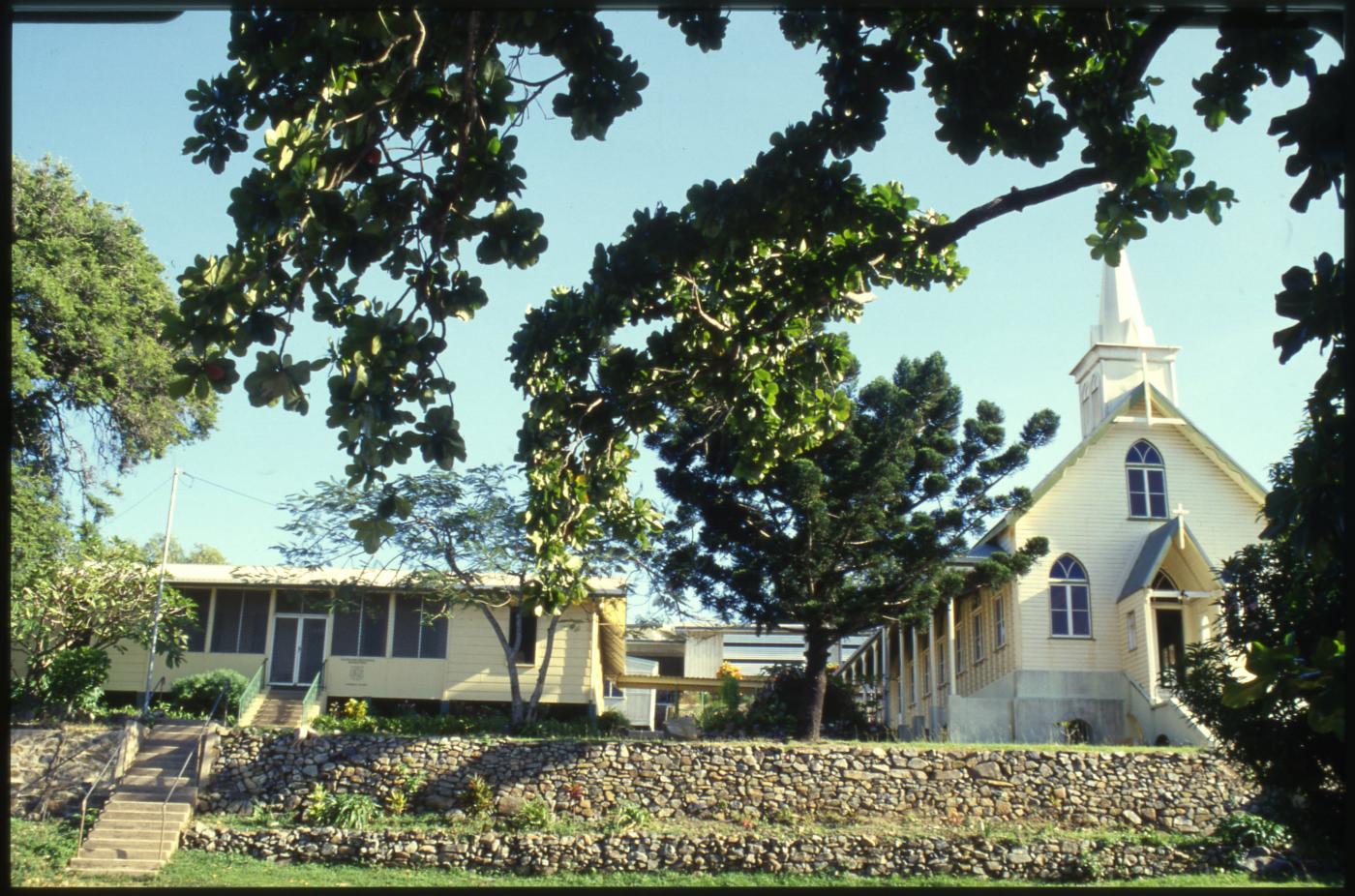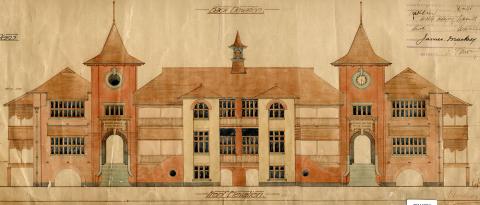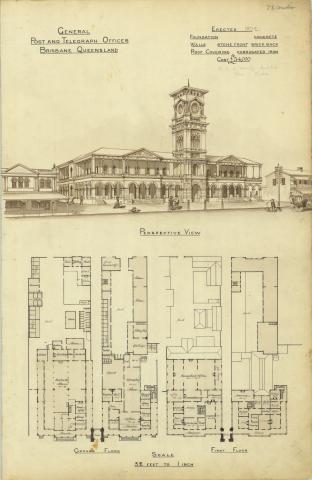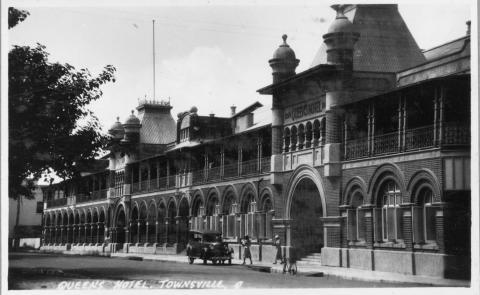
- News of the day
-
Capricornian, Thursday 1 March 1928, page 11
The Loss of the Quetta
It is one of the ironies of the sea that grim tragedy often lurks beneath the smoothest conditions, and the shadow of death is often masked by the most placid and disarming of exteriors. It was so in the case of the Quetta.
Nine o’clock on a perfect night! The bright moonlit sky was reflected in the almost unbroken surface of the sea. The Quetta’s bow cut cleanly through the water, sending long, phosphorescent ripples on either side. Who would dream of shipwreck under such condition? It was the last day of February 1890. The Quetta was within a few hours’ stream of Thursday Island, and some of the passengers were writing their letters – home letters full of excitement and hope – their last letters to be posted next day. Many of the passengers had retired for the night.
Just about 13 minutes past 9 they were conscious of a jar through the vessel. It was not a shock that would ordinarily cause alarm; still it made everyone look up and wonder if anything had happened. Surely nothing could be amiss in such a place, at such a time? Then came an ominous whisper:
“We have struck!” followed by the cry, “The water is coming in, it has reached the fires?"
There was very little time for anything at all when the ‘blow came, as the Quetta was slipping through the water at the rate of 10 ½ knots, and within three minutes she had disappeared beneath the calm surface and the sea was littered with hundreds of people fighting for their lives among such scraps of wreckage as broke adrift from her as she took the final plunge.
Most of the boats were lost or else went down with the ship, there being no time to cut them adrift, and only two were of any service. This one made several trips from the scene of the disaster to Adolphus Island where a large number of people were landed, but the swift tides soon dispersed the floating wreckage and people, and, although a number of people were rescued by the Government steamer Albatross next day, there is no doubt that numbers of others drifted away into eternity under the placid moon, probably enduring drawn out agonies before the end came.
Writing years later to a northern paper one of the survivors said:-
“It is almost impossible to define clearly what happened, or to place events in their proper sequence. I remember the numb feeling of horror that came on me; the hasty look round, to find that horror reflected in every face; the awful confusion, the rush to the stern of the boat, which was the highest out of the water. I had just time to help who was very dear up to a place beside me, when a great cry of terror went up , and the end came. It seemed to me that we were standing on an island and the sea was rising up. Up, up, it sent until, with a rush, it engulfed us.
“The moonlight was shut out, and down, down, down we went – a fighting, struggling mass of humanity – into a dreadful pit. It seemed an age; I learned, afterwards, it was exactly three minutes from the striking to the sinking. Time after time, as I fought for the air and light, I was trodden underfoot, and forced downwards. I suggested all the agonies of a dozen deaths. (If drowning be an easy death, as they say, then God help us in the hard ones, say I!) At last I gave up the fight, I could struggle no more. I must have reached that state of semi-consciousness that precedes death, when the mass of people separated a little and my head rose above the surface. I was almost beyond a struggle; but I was not unused to the water, and instinctively I turned on my back and lay floating there, gasping painful breath into my lungs. Then something round and soft bumped into me. I felt the fleece of a sheep.
Living, it might have had enough vitality to push me down and complete my end; dead it proved my means of rescue. With my fingers in the wool I clung to the floating carcass and held on till a hatchway floated near. Clinging to it were a white man and two or three blacks, and with a great desire to find some company, I swam to it, and placed my hands on the edge. Almost immediately afterwards the white man, evidently afraid that the frail raft would not support us all, tried to push off one of the blacks. Taking the dreadful hint, I, too, let go hold and floated off, trusting to find another means of safety.
“Soon after I struck my hand against a thick plank, which had been used to cover the open hatches, and had an iron ring fastened to each end of it. On this I spent the night, sometimes swimming and pushing it before me. At others drifting, and when sleep or unconscious overtook me, by passing my hands through the ring I was secure. The fear of sharks was a horror which haunted me and kept me splashing and kicking as long as I was able. Oftentimes I wonder that I did not lose my reason through that dreadful night, and but for the thought of a Divine Presence I might have done so.
“What a relief it was to see day dawn. Not far away there was a small island, and I worked with all my strength to reach it. Several times I though of discarding my plank, because it would been easier to swim without it, but finally held to it in case of exhaustion.
“When near enough to distinguish objects, I saw on the shore a black man, who, when he saw me, waved his hands as if to warn me off. (I have heard since that it is the native way of beckoning). Then I thought I saw sharks turning over and over in the water close to the shore. However I decided to take the changes and make for the land, as exhaustion was fast overtaking me. When near enough for him to reach me, the black boy walked out and dragged me in to shore, as I was quite unable to walk.
“Later I discovered that he was the captain’s cabin-boy. There was no water, no particle of shade on the island, and the heat throughout the day was intense. I took off my blouse to cover my head – the most of my clothes I had torn off during the night, as they hampered me. Thirst did not trouble me much – mental troubles leaving no room for bodily ailments. Several times during the day we talked of venturing on the sea again, and trying to make the mainland ; but the heat prevented us ; and, towards sundown, help came, in the shape of a rowing-boat, which took us to Somerset (near Thursday Island) where we received every possible care and attention.
“I found out, afterwards, I was the only white person who went over the stern of the boat, that was saved. That part was swarming with Javanese and the black crew. Next day we were taken to Thursday Island, where for many days I suffered acutely – mentally because of the loss of both my parents, and many dear friends; and physically, because of the terrible burning I received.”
THE DEATH ROLL
One hundred and thirty-three souls perished on that dreadful occasion, only one other young woman, and one dear baby girls, about 18 months old, survived of all the female passengers – saloon and steerage. One of the black crew saved the wee toddler, whose mother and fathered both drowned; and his disappointment was great when he was not allowed to retain possession of his little white mate. The other lady survivor was Miss Lacey, who was rescued after being in the water more than 18 hours.
Of the 282 souls on board 133 perished.- Captain Saunders was in command. The following is a list of saved: — Misses Lacey, Nicklin; Messrs. Corser, Clarke, Renton, Daveney. Steer-age: Messrs. J. Davidson, W. Wrathall, W. Gregory, G. G. Cameron, H. Ashford, J. Murphy, T. Train, A. B. Dunne, and one baby girl. Deck passengers, 53 Javanese and three Cingalese. Officers: Captain Saunders, Pilot Keating, and Messrs. Gray, Scott, Babb, Guy, Gervan; Quartermasters Traise, Oats, Shiells, and Johnson; the carpenter, Robinson; the baker, McGunn; the cook, McKenzie, and the immigrants' cook, Stallard (who saved the little girl).
It was next morning at half-past 10 o'clock before news of the disaster reached anyone, and then it was by the one serviceable boat carrying the dread tidings to Mr. F. Jardine, at Somerset, whence a messenger was despatched to the nearest telegraph station, from where it was flashed all over Australia. Mr. Jardine also placed the whole of his resources at the disposal of the survivors, and his own boats were always foremost among the anxious searchers.
Many a survivor owes his rescue to the intimate knowledge that this sturdy pioneer had of the tidal currents, and his name was breathed with gratitude in very many homes and is still remembered for the succour that he gave so unstintingly. Peace to his ashes. A courageous and outstanding figure in the history of the northernmost portions of Queensland, he did a man's job and left his mark, and passed on.
QUETTA ROCK
Quetta Rock is described in cold official language as "a most dangerous patch of small extent…" It has only 9 ft. of water over it at low tide and the Quetta was drawing 22 ft. 8 in., but, although she struck at just about high water the tidal rise thereabouts is only about 10 ft., and would give 19 ft. only. The rock is marked by tide rips, but these occur up there from reasons other than submerged rocks, and, in any case, there would be no rip in the period of slack water in which she struck. The wreck itself lies in deep water half-a-mile north west from the rock which caused the ship's tragic end, and was — up till a few years ago—indicated by strong tide rips, which will continue until such time as the corroding hand of time and the effects of salt water turn it back into the elements from which it came. In the course of the inquiry it was suggested that the rock on which the Quetta struck was the same as was struck by the Thales in 1877, but that was discounted by the court, the reason being that the evidence elicited at the Quetta inquiry tended to show that the Thales struck the fringing reef off the Brothers Islands. Still, there were stubborn mariners who clung to that opinion for a long time— even if there are not some to this day.
- Background
-
Our Lady of the Sacred Heart Church at Thursday Island was erected by French and Italian priests of the Mission of Our Lady of the Sacred Heart, who had arrived on the island in October 1884. On Thursday Island they established the first Catholic mission in the Torres Strait, erecting there a small church c1885. If this is the existing church [this is not substantiated], it is the oldest surviving building on Thursday Island. Photographic evidence suggests that by c1905, the church had acquired its present form and concrete footings.
On 24 October 1884 the first three Sacred Heart missionaries - Fr Louis André Navarre, Fr Ferdinand Hartzer, and Br Giuseppe de Santis - arrived at Thursday Island, soon to be joined by two more fathers and three young Italian brothers. Initially, Sunday mass was held at McNulty's Hotel [later the Federal Hotel], the congregation comprising mostly Filipino pearl-shell fishers [Manilla Men]. At Christmas the Filipinos came in their hundreds to attend mass and seek confession.
In January 1885 Frs Navarre and Hartzer purchased allotment 4 of section 4 [2 roods] in Port Kennedy for £6, at the first sale of crown land on Thursday Island. By February 1886 they had erected a small church and a dwelling house. By December 1886, Our Lady of the Sacred Heart mission at Thursday Island comprised three buildings, all constructed by the Italian brothers: a small, unpretentious iron church, some little distance up the hill, to one side of this a small convent accommodating four Sisters, and to the other a presbytery which also served as a sanatorium for fever-stricken and debilitated priests from New Guinea and other islands. It is not clear whether the c1885 church is the existing church.
From 1884 to 1889 Our Lady of the Sacred Heart mission at Thursday Island was the point of departure for all the Catholic missions - French, German, Swiss and other nationalities - in British New Guinea and New Britain. After 1889 the German Missionaries went directly to New Britain but the French continued to stop over at Thursday Island before going to their New Guinea mission headquarters at Yule Island. Later they went via Port Moresby.
Courtesy of the Queensland Heritage Register



